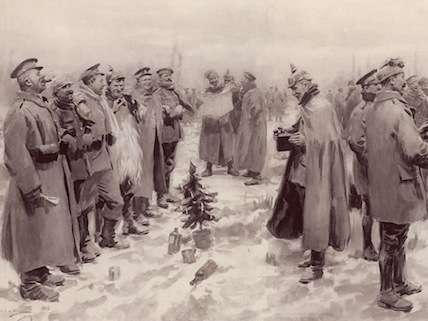There Was More Than One Christmas Truce
Officers tried to stop the Christmas Truce of 1914 from recurring, but they didn't always succeed.

In the famous Christmas Truce of 1914, memorialized in film and song, informal ceasefires were declared along the Western Front of World War I. British, French, and German soldiers met in No Man's Land, where they traded gifts, sang carols, played soccer, and buried their dead. It is remembered fondly today as a rare moment of humane behavior in one of the worst wars in European history.
But maybe it wasn't so rare after all. The Scotsman reports:
[H]istorian Thomas Weber, of the University of Aberdeen, has uncovered evidence that festive meetings continued throughout the war, with a significant number in 1916 despite the huge casualties suffered in the Battle of the Somme.
Professor Weber has been given access to a large number of family memories of the war that show that, despite officers recording in official documents that no such friendly exchanges took place, the situation on the front lines was very different.
Weber wrote about some of these truces in his 2010 book Hitler's First War. In the trenches near Fromelles in 1915, he reports, the authorities actively attempted to prevent a rerun of the previous Christmas by ordering "massive machine-gun fire," among other measures. Nonetheless, small-scale acts of fraternization took place. If they weren't as widespread as in 1914, Weber argues, that wasn't because the men were less willing; it's because the higher-ups were working harder to stop them.
They kept trying to stop them as the war dragged on, but sometimes peace broke out anyway. The Scotsman story mentions "a truce between German and Canadian troops at Vimy Ridge in 1916":
The official version of events recorded by the Canadian Regiment, Princess Patricia's Canadian Light Infantry, stated that the Germans tried to interact but that no one responded to it.
But the historian found that a letter written by Ronald MacKinnon, the son of a Scot from Levenseat, near Fauldhouse in West Lothian, tells a rather different story…."We had a truce on Xmas Day and our German friends were quite friendly. They came over to see us and we traded bully beef for cigars. Xmas was 'tray bon' which means very good."
In Hitler's First War, Weber notes that when the Canadian soldiers arrived at Vimy Ridge in October, some Germans had greeted the newcomers by holding up a sign that said "Welcome Canadians." (Another sign said: "Cut out your damned artillery. We, too, were at the Somme.") As December 25 approached, the authorities again tried to prevent a spontaneous holiday peace. Some officers even cancelled their men's Christmas rum ration, fearing that it would only encourage fraternization—but they didn't coordinate this as well as they could have, because some other officers decided to double their men's rum. In any event, "All attempts to prevent a truce had been futile. The men of the Princess Pats embarked on a truce with their German opponents, conversing with the help of a Canadian soldier who spoke German."
Bonus reading: I first learned about the 1914 Christmas Truce in Robert Axelrod's The Evolution of Cooperation, which covers it in a great chapter about the many ways "nonaggression between the troops emerged spontaneously in many places along the front." The chapter opens with a wonderfully frustrated quote from a British staff officer visiting the trenches—and not at Christmastime. He was
astonished to observe German soldiers walking about within rifle range behind their own line. Our men appeared to take no notice. I privately made up my mind to do away with that sort of thing when we took over; such things should not be allowed. These people evidently did not know there was a war on. Both sides apparently believed in the policy of "live and let live."

Show Comments (120)